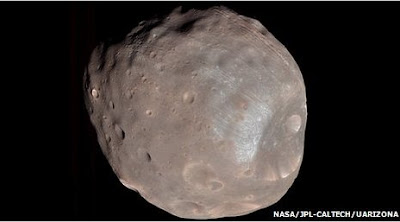 Nasa News Updates! Scientists say they have uncovered firm evidence that Mars's biggest moon, Phobos, is made from rocks blasted off the Martian surface in a catastrophic event.
Nasa News Updates! Scientists say they have uncovered firm evidence that Mars's biggest moon, Phobos, is made from rocks blasted off the Martian surface in a catastrophic event.The origin of Mars's satellites Phobos and Deimos is a long-standing puzzle.
It has been suggested that both moons could be asteroids that formed in the main asteroid belt and were then "captured" by Mars's gravity.
The latest evidence has been presented at a major conference in Rome.
The new work supports other scenarios. Material blasted off Mars's surface by a colliding space rock could have clumped together to form the Phobos moon.
Alternatively, Phobos could have been formed from the remnants of an earlier moon destroyed by Mars's gravitational forces. However, this moon might itself have originated from material thrown into orbit from the Martian surface.
Previous observations of Phobos at visible and near-infrared wavelengths have been interpreted to suggest the possible presence of carbonaceous chondrites, found in meteorites that have crashed to Earth.
This carbon-rich, rocky material, left over from the formation of the Solar System, is thought to originate in asteroids from the so-called "main belt" between Mars and Jupiter.
But, now, data from the European Space Agency's Mars Express spacecraft appear to make the asteroid capture scenario look less likely.
Recent observations as thermal infrared wavelengths using the Planetary Fourier Spectrometer (PFS) instrument on Mars Express show a poor match between the rocks on Phobos and any class of chondritic meteorite known from Earth.
These would seem to support the "re-accretion" models for the formation of Phobos, in which rocks from the surface of the Red Planet are blasted into Martian orbit to later clump and form Phobos.
"We detected for the first time a type of mineral called phyllosilicates on the surface of Phobos, particularly in the areas northeast of Stickney, its largest impact crater," said co-author Dr Marco Giuranna, from the Italian National Institute for Astrophysics in Rome.
These phyllosilicate rocks are thought to form in the presence of water, and have been found previously on Mars.
Read more>>




























0 comments:
Post a Comment
We encourage people to contact us with any comments regarding news or any other queries about this site. We will respond you respectively and promptly.
We are going to moderate comments only to avoid unwanted and spam messages.
Thanks for your interest ! ! ! ! ! ! !